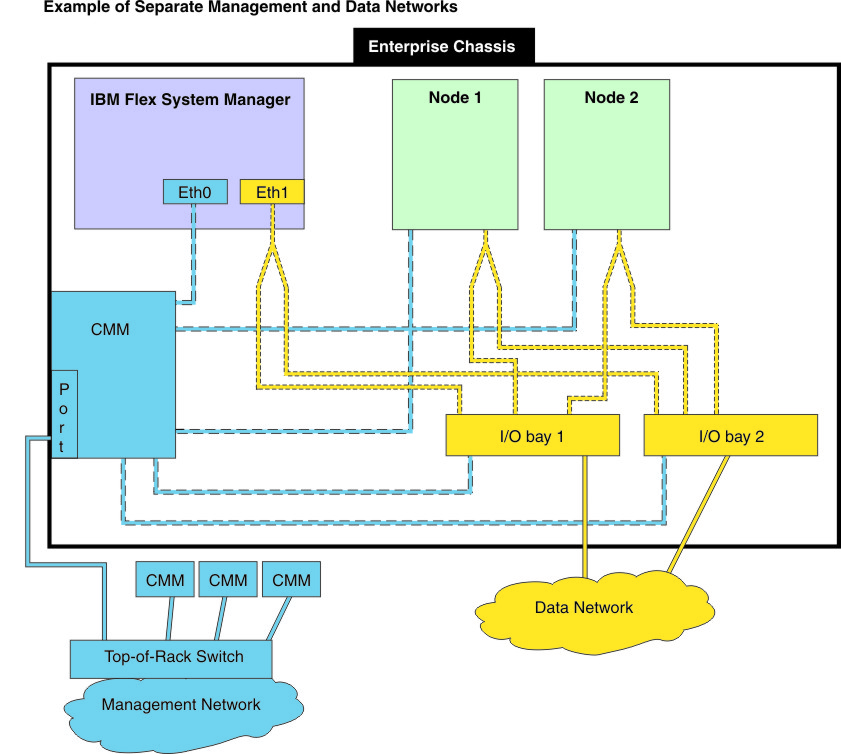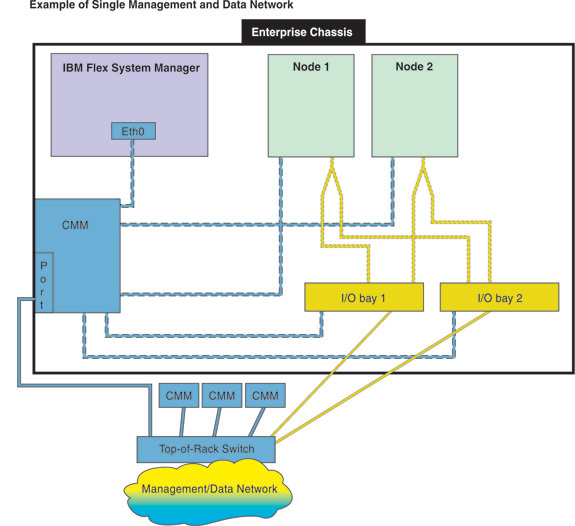Network integration with the Flex System Manager
In Flex System Enterprise Chassis with the Flex System Manager management node, you have the option to configure separate management and data networks.
- The illustrations in this section show management and data network examples when a single Chassis Management Module is installed in the chassis. Dual CMMs provide redundancy for the management fabric within the chassis as well as two separate uplinks from the chassis to the external network devices. You may choose to connect the redundant CMMs to redundant external Ethernet fabrics for added fault protection. The redundant CMMs within a chassis will automatically select the correct mode of operation based upon chassis and network status.
- Due to the design of the Flex System Enterprise Chassis, it is important to have all management network traffic on a separate subnet than the data traffic. This means all CMMs, IMMs, FSPs, and switch management interfaces should be on a different subnet/VLAN than the data production traffic of the other chassis components (such as node operating systems).
Management network
The Flex System Manager management node has two Ethernet interfaces which can be configured. The Eth0 port is connected to the Chassis Management Module (CMM) external Ethernet port through the chassis internal management network, effectively extending the chassis management network outside of the chassis. The CMM is connected to a top-of-rack switch that provides a central connection point for all chassis hardware to be managed by the Flex System Manager management software. These connections are referred to as the management network.
The management network is used to complete management-related functions for the various endpoints that are managed by the Flex System Manager management software, such as other Flex System Enterprise Chassis and compute nodes. During initialization the management software discovers any Flex System Enterprise Chassis on the management network. Note that the management node console can be connected to the management network or to the data network.

Data network
The Flex System Manager management node Eth1 port must be connected to the chassis switch modules that are installed in I/O bay 1 or bay 2. This is referred to as the data network. You can configure a switch module in bay 1 or bay 2 to map Eth1 to one of its external Ethernet ports, as you would configure the other nodes in the chassis that are connected to the external network. The data network is used by applications and operating systems and can support data transfer rates up to 10 Gbps if a chassis switch module that is capable of 10 Gbps is installed.
One of the key functions that the data network supports is discovery of operating systems on the various network endpoints. Discovery of operating systems by the Flex System Manager is required to support software updates on an endpoint such as a compute node. The Flex System Manager Checking and Updating Compute Nodes wizard assists you in discovering operating systems as part of the initial setup.
Single network configuration
You can also set up your environment so that the management network and data network are the same network. This is typically a simpler approach to network configuration and results in an easier setup process.
